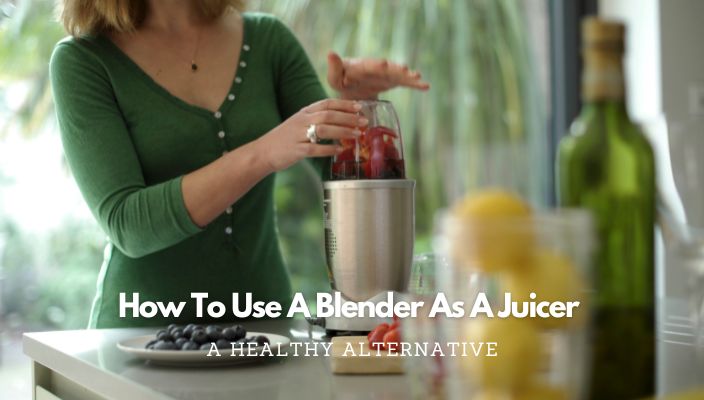It’s no secret that a blender is an essential kitchen appliance. Not only can it be used to create a variety of dishes, but it can also be used to craft nutritious juices and smoothies. Juicing your own fruits and vegetables is a great way to ensure that you are consuming a high-quality, nutrient-rich drink. With a few easy tips and tricks, you can use a blender to make fresh and delicious juices without investing in a juicer.
In this blog post, we will explore how to use a blender as a juicer and discover the countless health benefits that juicing has to offer. We will discuss the best ingredients for juicing, the importance of juicing, and the optimal settings for getting the most out of your blender.
By the end, you will have the knowledge and confidence to start juicing and take advantage of the many health benefits that come with it.
Juicing Vs Blending: Pros And Cons
Juicing and blending are both excellent ways of consuming fruits and vegetables and can be used to enhance your overall health. When it comes to juicing vs blending, there are pros and cons to both methods.
Juicing is a great way to quickly and easily consume an abundance of vitamins, minerals, and antioxidants found in fruits and vegetables. It’s also a good way to consume large portions of vegetables in a single serving, which helps to reach your daily nutritional goals. However, when juicing, it is important to note that some of the fiber and nutrition found in the whole food is lost.
Blending, on the other hand, allows you to consume whole food in a liquid form, which preserves fiber and nutrition and can help to regulate blood sugar levels. This means that you will get the most nutritional bang for your buck. However, it may take longer to consume a blended drink than it does to consume juice.
Ultimately, the choice between juicing and blending is a matter of personal preference, as both methods offer their own unique advantages and disadvantages.
The Steps Of Using A Blender As A Juicer
The greatest approach to extracting juice from fruits and vegetables is with a juicer since it helps you meet your daily nutritional requirements. If you don’t have a juicer with you, you can still create juice using a blender. Remember that using a blender will require you to put forth a little extra effort.
Below are the instructions for creating juice from fruits or vegetables.
1. Gather The Necessary Ingredients
Before you can use your blender as a juicer, you’ll need to gather all the necessary ingredients. This includes the fruits and vegetables you’ll be juicing, as well as any additional ingredients you might need, such as lemons, limes, or ginger. Be sure to wash all fruits and vegetables before use, as this will help ensure you get the most out of your juice! Also, don’t forget to stock up on ice cubes, as you’ll need these to make your juice extra cold and refreshing.
2. Pre-Cut Fruits And Vegetables
Pre-cut fruits and vegetables are the keys to using your blender as a juicer. Unlike juicers with a feed chute, blenders rely on blending the entire fruit or vegetable. To make sure that your blender is able to effectively blend your ingredients, it is important to cut them into small pieces before adding them to the blender. This way, your blender won’t be overworked and will be able to blend the ingredients into a smooth, consistent juice. Be sure to remove any pits or seeds before adding the fruit or vegetable to the blender.
3. Assemble The Blender
Once you have all the parts of your blender set up, it’s time to assemble it. Start by placing the motor base at the bottom. Then, attach the jar to the motor base. Next, attach the blade assembly to the jar, making sure it is securely locked in place. Finally, place the lid on top, making sure it is locked in place. You’re now ready to start juicing!
4. Blend And Strain
One of the most efficient methods of using a blender as a juicer is to blend your ingredients together and then strain out the pulp. To do this, simply fill the blender with your desired fruits, vegetables, and other ingredients, and blend until you have a smooth mixture.
Then, pour the mixture into a strainer over a bowl, and use a spoon to press the pulp against the sides of the strainer. The pulp will stay in the strainer, and the juice will drop down into the bowl. This method is great for extracting the most juice possible, although it can be a bit messy and time-consuming.
5. Clean Up And Enjoy
After you’ve finished blending your fruits and vegetables, it’s time to clean up and enjoy. Unplug the blender and remove the lid. Carefully pour out the juice into a cup or jug, then discard the solid remains of the fruits and vegetables in the compost. Clean up the blender by running it with a few drops of dishwashing liquid and some water, then rinse it off. Once it’s dry, store the blender away for your next juicing session. Enjoy your fresh and nutritious juice!
Closing Remarks
In conclusion, using a blender as a juicer is a great way to save time and money. It’s an excellent way to make delicious, healthy juices without the expensive cost of a juicer machine. With some creativity and experimentation, you can quickly whip up delicious and nutritious juices that your entire family will enjoy. So go ahead and give it a try – you won’t regret it!
Additional Resource:
- How To Use A Juicer Machine Simply And Effectively
- How To Make Grape Juice With A Blender?
- How To Make Carrot Juice With A Blender?
- How To Make Celery Juice With A Blender?

